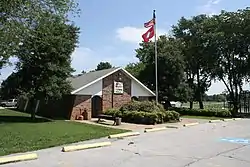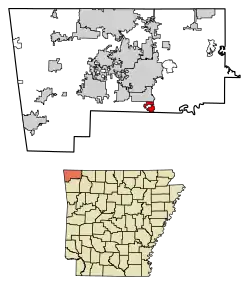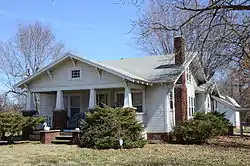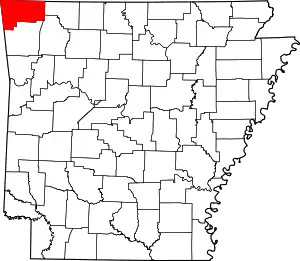Bethel Heights, Arkansas
Bethel Heights was a city in Benton County, Arkansas, United States. Always a small, sparsely populated community, the region coalesced around a school named Bethel in the late 19th century but did not incorporate until 1967 to avoid annexation by larger neighboring communities. The town offered police and fire protection and wastewater service to residents, but sent students to Springdale Public Schools and purchased water from Springdale Water Utilities. By the 21st century, Northwest Arkansas was gaining population rapidly, and Bethel Heights reincorporated as a city and grew from a population of 714 in 2000 to 2,372 at the 2010 census.[5] Growth put pressure on the city's subsurface discharge wastewater treatment system, and following a series of wastewater treatment plant violations, voters dissolved the city and completely annexed into Springdale in August 2020.[6]
Bethel Heights, Arkansas | |
|---|---|
 City Hall | |
 Flag  Seal | |
 Location of Bethel Heights in Benton County, Arkansas. | |
| Coordinates: 36°13′22″N 94°7′40″W | |
| Country | United States |
| State | Arkansas |
| County | Benton |
| Government | |
| • Type | Mayor-council |
| Area | |
| • Total | 2.22 sq mi (5.76 km2) |
| • Land | 2.21 sq mi (5.74 km2) |
| • Water | 0.01 sq mi (0.03 km2) |
| Elevation | 1,348 ft (411 m) |
| Population (2010) | |
| • Total | 2,372 |
| • Estimate (2019)[3] | 2,771 |
| • Density | 1,251.02/sq mi (482.94/km2) |
| Time zone | UTC-6 (Central (CST)) |
| • Summer (DST) | UTC-5 (CDT) |
| ZIP Code | 72764[4] |
| Area code | 479 |
| FIPS code | 05-05740 |
| GNIS feature ID | 0076320[2] |
| Website | web |
History

Present-day Benton County was hunted by the Osage prior to, and after, the Louisiana Purchase. Following the Treaty of Fort Clark and establishment of Lovely County, white settlement in the area began. Settlers around Bethel Heights started claiming land in 1856.
As the communities of Lowell and Springdale expanded toward the Bethel area, residents incorporated as a town in 1967 to prevent annexation.[7]
Geography

Bethel Heights was located in southern Benton County at 36°13′22″N 94°7′40″W (36.222843, -94.127671).[8] It was bordered by Springdale to the east, south, and west, and by Lowell to the north. U.S. Route 71 Business (US 71B, Thompson Street) ran north-south along the western side of the city, and Highway 264 ran east-west through the center of the city.
According to the United States Census Bureau, the city had a total area of 2.4 square miles (6.2 km2), of which 0.015 square miles (0.04 km2), or 0.69%, is water.[5]
Region
The Northwest Arkansas region consists of three Arkansas counties: Benton, Madison, and Washington. The area had a population of 347,045 at the 2000 census which had increased to 463,204 by the 2010 Census (an increase of 33.47 percent). The region does not consist of the usual principal-city-with-suburbs morphology. The principal cities retain individual identities, but have grown together along Interstate 49 (I-49). For more than the last decade, Northwest Arkansas has been one of the fastest-growing regions in the United States.[9]
Demographics
| Census | Pop. | Note | %± |
|---|---|---|---|
| 1970 | 284 | — | |
| 1980 | 296 | 4.2% | |
| 1990 | 281 | −5.1% | |
| 2000 | 714 | 154.1% | |
| 2010 | 2,372 | 232.2% | |
| 2020 | 3,015 | 27.1% | |
| U.S. Decennial Census[10] 2014 Estimate[11] | |||
As of 2010 Bethel Heights had a population of 2,372. The racial and ethnic composition of the population was 49.7% non-Hispanic white, 1.9% black or African American, 1.4% Native American, 3.0% Asian, 8.3% Pacific Islander, 21.6% from some other race, 2.2% from two or more races, and 34.7% Hispanic or Latino.[12]
As of the census[13] of 2000, there were 714 people, 251 households, and 211 families residing in the town. The population density was 109.4/km2 (282.8/mi2). There were 261 housing units at an average density of 40.0/km2 (103.4/mi2). The racial makeup of the town was 92.16% White, 1.54% Native American, 2.52% Asian, 1.82% from other races, and 1.96% from two or more races. 3.36% of the population were Hispanic or Latino of any race.
There were 251 households, out of which 42.6% had children under the age of 18 living with them, 78.1% were married couples living together, 3.2% had a female householder with no husband present, and 15.9% were non-families. 13.9% of all households were made up of individuals, and 7.2% had someone living alone who was 65 years of age or older. The average household size was 2.84 and the average family size was 3.10.
The city's population was spread out, with 28.6% under the age of 18, 5.2% from 18 to 24, 31.0% from 25 to 44, 24.2% from 45 to 64, and 11.1% who were 65 years of age or older. The median age was 35 years. For every 100 females, there were 103.4 males. For every 100 females age 18 and over, there were 103.2 males.
The median income for a household in the town was $48,750, and the median income for a family was $51,172. Males had a median income of $33,438 versus $26,625 for females. The per capita income for the town was $19,001. About 1.9% of families and 4.9% of the population were below the poverty line, including 1.8% of those under age 18 and 11.4% of those age 65 or over.
Education
The majority of the former city of Bethel Heights is zoned for Springdale Public Schools while small sections are zoned to Rogers Public Schools.[14]
The Bethel Heights area (the former municipality) in 2022, was zoned to the following: Bayyari, Hunt, and Monitor elementary schools take certain portions. Hellstern, Sonora, and Helen Tyson middle schools take certain portions. Central, Lakeside, and Southwest junior high schools take certain portions. Springdale High School and Har-Ber High School take certain portions of Bethel Heights.[15]
Bethel Heights, in 2006, was divided between Bayyari, Hunt, and Lee elementary schools.[16] It was also divided between Hellstern, J.O. Kelly, and Helen Tyson middle schools,[17] and between Central, Southwest, and George junior high schools.[18] Most of Bethel Heights was zoned to Springdale High, but with portions west of U.S. Route 71 zoned to Har-Ber.[19]
Early residents established Benton County School District #66, and a small school known as Bethel or New Kirk, around Bethel Heights in the late 19th century.[20] This school remained independent until consolidation with Springdale Public Schools in 1948.[7] In 2018, Springdale Public Schools became the largest school district in the state with over 23,000 students.[21] Bethel Heights students were zoned for graduation from Springdale High School.
Government and politics
Mayor–city council
Bethel Heights operated within the mayor-city council form of government. At founding as a town, Bethel Heights had a town council consisting of five aldermen elected at-large as the town's unicameral legislature.[22] Mayors served an unlimited number of four-year terms. The mayor was elected by a citywide election to serve as the Chief Executive Officer (CEO) of the city by presiding over all city functions and allocated duties to city employees. Bethel Heights also elected a recorder and treasurer to two-year terms.
In the early 2000s, Bethel Heights became a second-class city, requiring the establishment of wards. Two council members were elected to two-year terms from each of the city's three wards to establish an annual budget and consider ordinances. Council meetings were held on the third Tuesday of each month at 7:00 p.m. at City Hall, 530 Sunrise Drive. On August 21, 2020, Bethel Heights was annexed by Springdale.
Infrastructure

Utilities
The City provided wastewater service via a STEP system, installed in 2003.[23] Bethel Heights struggled to maintain compliance with Arkansas Department of Health and Arkansas Department of Environmental Quality regulations. The system was out of compliance from August 2013 to January 2017, with sewage surfacing in neighbors' fields, livestock poisonings, multiple violations and fines resulting in a consent administrative order. Violations had continued in 2018 and 2019.[24]
Potable water service was provided by Springdale Water Utilities. Following the sewer system violations, a moratorium on new water system connections was established in June 2019.[25]
American Electric Power (AEP/SWEPCO) and Carroll Electric Cooperative provided electric power in Bethel Heights.[26] Franchise utilities that served the community include AT&T, Black Hills Energy, and Cox Communications.
References
- "2019 U.S. Gazetteer Files". United States Census Bureau. Retrieved June 30, 2020.
- U.S. Geological Survey Geographic Names Information System: Bethel Heights, Arkansas
- "Population and Housing Unit Estimates". United States Census Bureau. May 24, 2020. Retrieved May 27, 2020.
- Sosa, Ninette (August 12, 2020). "A CLOSER LOOK: what happens to ZIP code 72764, Bethel Heights?". KFTA, Nexstar Media Group Inc. Retrieved August 17, 2020.
- "Geographic Identifiers: 2010 Demographic Profile Data (G001): Bethel Heights city, Arkansas". U.S. Census Bureau, American Factfinder. Archived from the original on February 12, 2020. Retrieved September 20, 2013.
- "Springdale, Bethel Heights city officials working well together". August 15, 2020.
- Teske, Steven (August 5, 2020). "Bethel Heights (Benton County)". Encyclopedia of Arkansas. Little Rock, Arkansas: Butler Center for Arkansas Studies at the Central Arkansas Library System. Retrieved August 17, 2020.
- "US Gazetteer files: 2010, 2000, and 1990". United States Census Bureau. February 12, 2011. Retrieved April 23, 2011.
- "Northwest Arkansas leads growth in state, 14th fastest-growing metro area nationwide – Talk Business & Politics". Talk Business & Politics. March 22, 2018. Retrieved May 6, 2018.
- "Census of Population and Housing". Census.gov. Retrieved June 4, 2015.
- "Annual Estimates of the Resident Population for Incorporated Places: April 1, 2010 to July 1, 2015". Archived from the original on October 19, 2016. Retrieved June 26, 2016.
- 2010 general profile of population and housing characteristics of Bethel Heights from the US census
- "U.S. Census website". United States Census Bureau. Retrieved January 31, 2008.
- "2020 CENSUS - SCHOOL DISTRICT REFERENCE MAP: Benton County, AR" (PDF). U.S. Census Bureau. Retrieved May 25, 2022.
- "School Information Locator Springdale Public Schools". VMax Compass. Retrieved September 18, 2022. - Linked from here
- "Elementary School Zones" (PDF). Springdale Public Schools. Archived from the original (PDF) on May 22, 2006. Retrieved September 17, 2022.
- "Middle School Zones" (PDF). Springdale Public Schools. Archived from the original (PDF) on May 22, 2006. Retrieved September 17, 2022.
- "Junior High School Zones" (PDF). Springdale Public Schools. Archived from the original (PDF) on May 22, 2006. Retrieved September 17, 2022.
- "High School Zones" (PDF). Springdale Public Schools. Archived from the original (PDF) on May 22, 2006. Retrieved September 17, 2022.
- Black, J. Dickson (1975). History of Benton County. Little Rock, Arkansas: International Graphics Industries. LCCN 75-31495. OCLC 1967335.
- "Springdale Named Largest School District In Arkansas". KFSM. September 3, 2018. Retrieved May 18, 2019.
- Town Council of Bethel Heights, Arkansas (September 30, 1968). "Ordinance No. 1" (PDF). Town of Bethel Heights, Arkansas. Retrieved August 17, 2020.
- Molatore, Tyler (March 2, 2016). "Sewer & Collection Systems: Saving Bethel Heights". Water & Wastes Digest. Scranton Gillette Communication. Retrieved July 23, 2019.
- Joenks, Laurinda (June 23, 2019). "Records show state allowed years of violations in Bethel Heights". Northwest Arkansas Democrat Gazette. WEHCO Media. Retrieved July 23, 2019.
- Joenks, Laurinda (June 5, 2019). "New water service denied to Bethel Heights at state's request". Northwest Arkansas Democrat-Gazette. WEHCO Media. Retrieved July 23, 2019.
- Electric Utility Service Territories (polygon) (Map) (Update ed.). Arkansas GIS Office. October 16, 2014 [June 5, 2009]. Retrieved April 7, 2019.
External links
- City of Bethel Heights official website (archived)
- "2020 CENSUS - CENSUS BLOCK MAP: Bethel Heights city, AR" (PDF). U.S. Census Bureau. Retrieved September 18, 2022. - 2010 map, 2000 map
- 1990 maps: Benton County pages 29 and 30
- "Zoning Map 2008-2009" (PDF). Bethel Heights. Archived from the original (PDF) on December 27, 2016.
